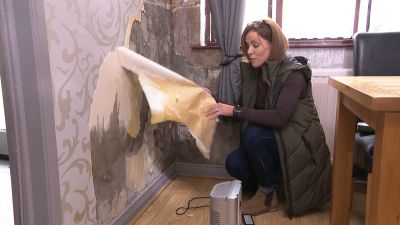Rising damp, a subject often steeped in debate and occasionally misdiagnosed, primarily affects walls at ground level. Recognizing the signs of rising damp is crucial to address this issue effectively. These symptoms may include:
- Tide Marks on Internal Walls
- Efflorescence on Exterior Walls
- Damage to Wallpaper, Paint, and Plaster
- An unpleasant damp smell in the property.
To demystify the concept of rising damp, it’s essential to understand the underlying theory. Rising damp occurs when groundwater surrounding a property gradually ascends through the porous brickwork or stonework via capillary action. The dampness can be absorbed to a height of up to 1.5 meters, with an average height of 1.2 meters. Beyond this point, the force of gravity eventually overcomes the capillary action.
In an ideal scenario, rising damp should not occur, thanks to the building industry’s requirement to incorporate a Damp Proof Course (DPC) in new constructions since the enactment of the Public Health Act of 1875, extending through to The Building Regulations of 2010. The Damp Proof Course (DPC) essentially functions as an impermeable barrier, usually positioned about six inches above ground level. Historically, it consisted of a thin course of slate or bitumen, but in modern times, it involves highly advanced and efficient damp-proof membranes. Unless your property predates 1875, it should have a DPC in place, preventing rising damp. However, issues with the DPC, unfortunately, are not uncommon.
Causes of Rising Damp:
-
Absence of a DPC: Older buildings, constructed prior to 1850, were typically built without a DPC. In the Edwardian and early Victorian eras, allowing air circulation between the interior and exterior of a house was standard practice to maintain low internal moisture levels. Fireplaces played a significant role in this by drawing in outside air through features like air bricks, gappy floorboards, and deliberate gaps in slates or sash windows. Renovating such older properties without installing a modern, effective DPC can lead to rising damp, as internal moisture remains unventilated.
-
Aging DPC: DPCs that have been in place for decades, particularly those installed during the early 20th century construction or added later to renovated older houses without original DPCs, can deteriorate due to unforeseen chemical interactions over time or subpar installation. As scientific knowledge advances, newer DPCs offer improved performance.
-
Compromised DPC: In relatively newer houses, rising damp may occur due to a compromised DPC. This can happen when moisture is allowed to penetrate above the damp proof course, often due to various factors such as:
- External ground levels surpassing the DPC at some point.
- Accumulated soil against the wall over time.
- Debris in the wall cavity.
- External or internal renders extending below the DPC.
- Inappropriate cavity insulation.
- Solid floors constructed post-DPC, bridging the divide.
- Adjoining masonry without a DPC or with a DPC at a higher level.
Understanding the symptoms and underlying causes of rising damp is essential to effectively address and prevent this issue in your property. If you suspect rising damp, Contact Us today for a comprehensive assessment and advice on remediation.


